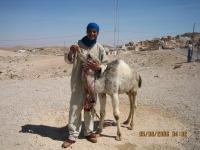I don’t remember much about the trip, only that we were thirsty. We would stop, we would move. At one station, it could have been Raasiku, we saw Uncle Ruudi. He was able to hand mother a parcel. Later, Uncle Ruudi had been spotted at another station. At some stops, a few people were allowed out to get water. In our family, it was Eva who went. We had been able to get the upper bunk near the window. During the journey, I tried to look out the window, but I don’t remember what I was looking at. Still - I have a vague recollection of children in drab, ragged clothes approaching the train with their hands stretched out. I had not seen children like that before, either.
One story I heard years later from Õie. Little Peet, Uncle Aleksander’s son was not with us on the journey to Russia. He had been sent to Põltsamaa for the summer, and thus escaped deportation. But one of his shoes was en route to Russia. Aunt Gertrude wrote his address on the sole of the shoe, and threw it out the window before we reached Narva. The shoe got to Peet.
The following people were in the same car with us: Leida Kuura and her daughter Iris, Maali Käsper, Ida Martinson and her son Rudolf, Hilda Otmann and her daughters Alice and Vilma, Leonilla Puu, Dagmar Simsivart and her sons Viktor and Ilmar, and Juuli Solvak and her daughter Ly. (Aunt Gertrud and Aunt Helma were in another car with their children). Now that I think back on it, we got off lightly on our journey. We only had 17 people in our car - none of them seriously ill, or elderly, or infants. I was the youngest, but quite grown up - I had turned eight.
When we arrived in Kotelnich, we learned that the war had started. . After that the talk was only about the war and the front moving towards us. And sure enough, at Kotelnich station we were taken off the train and the journey continued by barge down the Vjatka River. But I don’t remember much about the trip itself on the barge. Why has this part of my life-story been lost?
Advertisement / Reklaam
Advertisement / Reklaam
We were destined to be placed in the little village of Malyshi on the Voya River. Aunt Gertrud and Jaak and Õie and Aunt Helma, Toomas, Karin and Ines ended up in the same village. So all 10 of us who were related were to-gether. Who were the other deportees placed in Malyshi? Adele Akel, the wife of Dr. Friedrich Akel, the former prime minister, who had held many cabinet positions, and been a member of the Estonian Parliament. Asta Treude, the daughter of Adele and Friedrich Akel, and her children Asta-Maria and Jaan. Her husband Damasius Treude was in the Ministry of Foreign Affairs, and had been attache at the Estonian Embassy in Berlin. Ilse Andrei with her children Imbi and Jaan. She was the wife of Jaan Andrei, a merchant and home-owner in Nõmme. Johan Andrei, an 80-year -old gentleman, who was the father-in-law of Ilse Andrei. Salme Kuldvere - a hair-dresser, and the wife of police -officer August Kuldvere. Elfriede Mänd and her daughters Marika and Tiia. Her husband was Aleksander Mänd, who worked for the Estonian Railways. Juhan Kuben - a young economist, who had done post-graduate work in law. His wedding had taken place on June 14. He was caught on the next day and put on our train at Raasiku. (His wife wanted to go with him, but she was not allowed to get on the train.) Alma Polosuhhin with her son Georgy who had voluntarily come along to be with her husband. Dagmar Simsivart and her sons Viktor and Ilmar. She was the wife Voldemar Simsivart, an economist, who had fought in the War of Independence and was the Chief Executive Officer of the Polaris Insurance Company. Julie Solvak and her daughter Ly. She was the wife of Mihkel Solvak, the manager of the peat processing plant in Pääsküla, and a home-owner. Alice Taimsalu and her daughter Urve. She was the wife of a professor at the Tallinn Technical University. Natalie Õunapuu and her children Helgi-Tiia and Andres. She was the wife of Arnold Õunapuu, an attorney. Vilhelmine Varts with her son Mart. She was the wife of Elmar Varts, the deputy chief of the security police. In due course, news reached us of other Estonians, who had also been placed in Kirov oblast, on the European side of the Urals. Most of the towns and villages where the Estonians had been placed were on the Vjatka or its tributaries - Belaya Holunica, Polom, Sovetsk, Orishi, Stretensk, Nema, Durma, Lebjaze, Perevoz, Nagorsk, Urzum, Malmys, Malyshi, and so on. There were over two thousand of us, Estonians, deported to Kirov oblast.Advertisement / Reklaam
Advertisement / Reklaam
We were not placed in prison cells or prison camps - we were “free” and integrated with the local people. We could move around within a given territory, but at intervals the adults in the family had to register themselves at the local NKVD office.Looking back now, I think that the fates were relatively kind to those of us who were placed in the village of Malyshi in the Molotovsk rajon. In spite of everything, the living conditions there enabled the mothers to keep their children from starving to death. Nine-year-old Tiia Õunapuu died in Malyshi, but her death was not directly caused by starvation. On the other hand, the men of the families sent to Malyshi, if not already arrested earlier, had been separated from their families, when we were loaded into the box-cars. They were sent to Russian prisons and slave labour camps. None of them ever came back. More than half of them had been destined to be shot.
(To be continued)




















